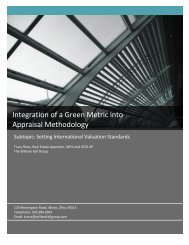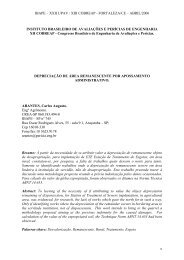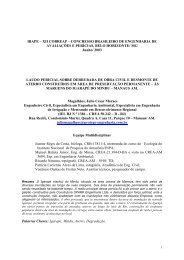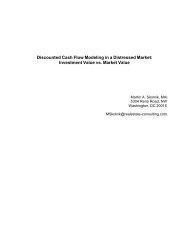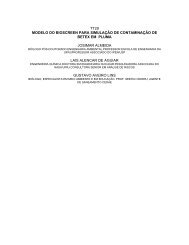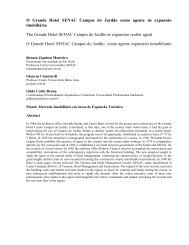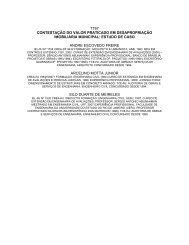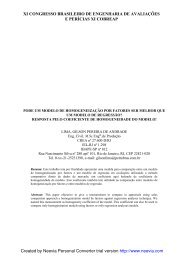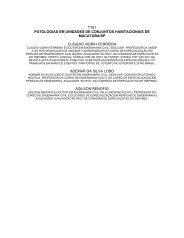Form Follows Function: Reporting Market Trend Data ... - mrcl.com.br
Form Follows Function: Reporting Market Trend Data ... - mrcl.com.br
Form Follows Function: Reporting Market Trend Data ... - mrcl.com.br
You also want an ePaper? Increase the reach of your titles
YUMPU automatically turns print PDFs into web optimized ePapers that Google loves.
<strong>Form</strong> <strong>Follows</strong> <strong>Function</strong>:<<strong>br</strong> />
<strong>Reporting</strong> <strong>Market</strong> <strong>Trend</strong> <strong>Data</strong> Via The URAR and 1004MC<<strong>br</strong> />
By:<<strong>br</strong> />
Tammie L. True<<strong>br</strong> />
1317 Farley Ct South<<strong>br</strong> />
Arnold, MD 21012<<strong>br</strong> />
410-903-1073<<strong>br</strong> />
tammietrue@<strong>com</strong>cast.net<<strong>br</strong> />
XXV UPAV Congress<<strong>br</strong> />
Theme<<strong>br</strong> />
Valuing Our World: Challenges Facing The Global <strong>Market</strong><<strong>br</strong> />
Subtopic<<strong>br</strong> />
Raising The Valuation Profession Through Enhanced Education and Training
Abstract
Table of Contents<<strong>br</strong> />
Summary……………………………………………………………………………………i<<strong>br</strong> />
The More Things Change, The More They Stay The Same ………………………….1<<strong>br</strong> />
Bursting The Bubble Of Blame……………….………………………………….….……1<<strong>br</strong> />
Communicate, Innovate, Educate and Train…………..……...………….……...……2<<strong>br</strong> />
<strong>Market</strong> Analysis and 1004MC <strong>Data</strong>: A Sample Worksheet…………...………………3<<strong>br</strong> />
Sample Worksheet – Figure 1…………..…………………………………………..…..4<<strong>br</strong> />
The Declining <strong>Market</strong>……………………………………………………………………5<<strong>br</strong> />
Matrix of <strong>Market</strong> <strong>Trend</strong> Results – Figure 2……………………………………………..6<<strong>br</strong> />
<strong>Market</strong> <strong>Data</strong><strong>Trend</strong> Results………………..………………………………………… … . .7<<strong>br</strong> />
<strong>Market</strong> Analysis and 1004MC <strong>Data</strong>: Sample Worksheet…………...…………………7<<strong>br</strong> />
Case Study: Figure 3……………………………………………………………………..8<<strong>br</strong> />
Case Study: Figure 4……………………………………………………………………9<<strong>br</strong> />
Case Study: Figure 5…………………………………………………………………10<<strong>br</strong> />
References……………………………………………………………………………….11
The More Things Change, The More They Stay The Same (Or Do They?)<<strong>br</strong> />
The 1980’s Savings and Loan Crisis was described as the greatest banking collapse<<strong>br</strong> />
since the Great Depression. Two decades later much the same, and then some, is<<strong>br</strong> />
circulating about the ongoing Great Recession of 2007. And although admittedly<<strong>br</strong> />
different in cause, effect and out<strong>com</strong>e, one <strong>com</strong>mon thread of discourse is strikingly<<strong>br</strong> />
similar: the blame-game. The finger pointing knows no bounds with seemingly plenty of<<strong>br</strong> />
blame to go around including the government, lenders, mortgage industry, investment<<strong>br</strong> />
banks, unqualified homebuyers, as well as over-valued appraisals.<<strong>br</strong> />
However, as evidenced by the enactment of the Financial Institutions Reform Recovery<<strong>br</strong> />
and Enforcement Act of 1989 (FIRREA), history dictates that calamity often precipitates<<strong>br</strong> />
necessary change. And as further evidenced by the progress made thus far,<<strong>br</strong> />
specifically in terms of the HVCC and the 1004MC, the most effective change stems<<strong>br</strong> />
from the coordinated effort of many. In fact, during an interview by “The National<<strong>br</strong> />
Mortgage Professional Magazine,” David H. Stevens, FHA Commission, was asked<<strong>br</strong> />
what he thought about the mortgage <strong>br</strong>oker having been “portrayed as a major culprit in<<strong>br</strong> />
the mortgage mess by both the media and select legislators.” Stevens responded, “I<<strong>br</strong> />
shudder whenever I see someone point the finger of this housing problem at any one<<strong>br</strong> />
particular area of the market. At the end of the day….we are all responsible.” 1 Toward<<strong>br</strong> />
that end, in the words of another whose industry has rivaled the challenges of calamity<<strong>br</strong> />
and change, Henry Ford championed the phrase: “Don’t find fault, find remedy.”<<strong>br</strong> />
Bursting The Bubble Of Blame<<strong>br</strong> />
As the credit crunch in 2007 turned into a full financial meltdown in 2008 ultimately<<strong>br</strong> />
leading to a global recession, not one faction of the financial or housing industry was<<strong>br</strong> />
immune to the fall out. Accepting that “we are all responsible,” fosters the realization<<strong>br</strong> />
that we are also inextricably intertwined in terms of both the problem(s) and the<<strong>br</strong> />
solution(s). Leslie P. Sellers, MAI, SRA, President, Appraisal Institute, aptly surmised<<strong>br</strong> />
“Let’s not let a good crisis go to waste. The current environment opens doors that might<<strong>br</strong> />
not otherwise be open for us to articulate our profession’s importance to good financial<<strong>br</strong> />
decision-making processes.” 2 1
Communicate, Innovate, Educate and Train<<strong>br</strong> />
Appraisal quality is critical to the risk management process. “The loss from overvalued<<strong>br</strong> />
properties extends beyond the immediate client, the secondary market, and investors –<<strong>br</strong> />
the profound impact is the effect of overvalued properties on the overall economy and<<strong>br</strong> />
ultimately, the consumer and taxpayers.” 3 Communicating the importance of our<<strong>br</strong> />
profession to good financial decision-making processes begins with quality appraisals,<<strong>br</strong> />
the foundation of which is market analysis. However, one of the most <strong>com</strong>mon<<strong>br</strong> />
deficiencies cited by lenders is appraiser misreporting in the neighborhood trends<<strong>br</strong> />
section of the URAR.<<strong>br</strong> />
While some potentially obvious causes for this deficiency are explored in subsequent<<strong>br</strong> />
pages, consideration of the less-than-obvious begs the question: does the URAR form,<<strong>br</strong> />
now utilized in conjunction with the 1004MC (<strong>Market</strong> Conditions Addendum), best<<strong>br</strong> />
facilitate the function for which its intended?<<strong>br</strong> />
For instance, per the FHA Mortgagee Letter dated March 23, 2009, regarding the<<strong>br</strong> />
implementation of the 1004MC, “Although there is no standard industry definition…a<<strong>br</strong> />
declining market is considered to be any neighborhood, market area or region that<<strong>br</strong> />
demonstrates a decline in prices or deterioration in other market conditions as<<strong>br</strong> />
evidenced by an oversupply of existing inventory or extended marketing times. A<<strong>br</strong> />
declining trend in the market will be identified by the conclusions of the 1004MC.” 4<<strong>br</strong> />
While the inclusion of the 1004MC succeeded in providing transparency in the reporting<<strong>br</strong> />
of neighborhood trends, the form falls short of facilitating a full assessment of<<strong>br</strong> />
neighborhood trends, most often due to an extreme lack of <strong>com</strong>parable sales data.<<strong>br</strong> />
Sales data in a declining market is very limited and not always sufficient to fully identify<<strong>br</strong> />
some, or all, of the market trends observed in the neighborhood. Conversely, the<<strong>br</strong> />
neighborhood analysis trend data is based on all sale/listing data in the subject<<strong>br</strong> />
neighborhood, which may include properties that are not directly <strong>com</strong>parable to the<<strong>br</strong> />
subject. In the neighborhood trend analysis, there is often more data to draw<<strong>br</strong> />
conclusions from as it is based on the typical buyer wanting to live in a specific market<<strong>br</strong> />
2
area, which en<strong>com</strong>passes a variety of homes, <strong>com</strong>mercial uses and similar influence,<<strong>br</strong> />
all of which play a part in understanding market trends. 5 That said, a 1004MC form that<<strong>br</strong> />
incorporated on one page neighborhood trend data from both micro and macro<<strong>br</strong> />
perspectives would be optimal.<<strong>br</strong> />
<strong>Market</strong> Analysis and 1004MC <strong>Data</strong>: A Sample Worksheet<<strong>br</strong> />
A sample worksheet is included on the following page. The expanded 1004MC format<<strong>br</strong> />
incorporates subject info, as well as macro and micro neighborhood info, in addition to<<strong>br</strong> />
the identification of existing sub-markets. Initially designed to expedite market data<<strong>br</strong> />
collection during the appraisal process, the form is also used for in-house reviews, as<<strong>br</strong> />
well as a teaching tool for trainees.<<strong>br</strong> />
Most notably, as illustrated by the Case Study included on page nine, incorporating the<<strong>br</strong> />
general neighborhood data along with the subject-specific 1004MC information provides<<strong>br</strong> />
a <strong>com</strong>prehensive, at-a-glance understanding of market trends for appraisers,<<strong>br</strong> />
underwriters, appraisal reviewers and quality control personnel. Underwriters and<<strong>br</strong> />
appraisal reviewers, especially, have limited time to review appraisal reports and in<<strong>br</strong> />
most cases have limited firsthand knowledge of the subject property’s market.<<strong>br</strong> />
3
Sample Worksheet – Figure 1<<strong>br</strong> />
4
The Declining <strong>Market</strong><<strong>br</strong> />
As summarized by David Phillips, SRA, in Appraising In A Declining <strong>Market</strong>: A Practical<<strong>br</strong> />
Guide For The Residential Appraiser, “A generation of appraisers has been dealing with<<strong>br</strong> />
rising values. For many, the present situation is the first experience with a declining<<strong>br</strong> />
market.” 6<<strong>br</strong> />
This observation is further supported by empirical data collected via an ad hoc study by<<strong>br</strong> />
the author that examines market trend data reported in URAR reports written during<<strong>br</strong> />
2004 through the first half of 2010. This was a blind study; i.e., only the market analysis<<strong>br</strong> />
sections and pertinent property-specific information were collected. Comprised of<<strong>br</strong> />
properties located throughout the state of Maryland, the reports were written over the<<strong>br</strong> />
course of six years by roughly 27 licensed appraisers, which included Certified General,<<strong>br</strong> />
Certified Residential and Licensed designations.<<strong>br</strong> />
Specifically, the report data was retrospectively examined in relation to the effectiveness<<strong>br</strong> />
of reporting market trend analysis data via the URAR form during periods of significant<<strong>br</strong> />
market change. The data was further segregated by effective date into one of the<<strong>br</strong> />
following three timeframes: a) prior to the economic downturn [2004-2005], b) at the<<strong>br</strong> />
height of the market decline [2006-2008], and c) post implementation of the 1004MC<<strong>br</strong> />
[2009-2010].<<strong>br</strong> />
Included on the following page is a matrix of report market trend results.<<strong>br</strong> />
5
Figure 2<<strong>br</strong> />
Year # Reports <strong>Market</strong> <strong>Data</strong> <strong>Trend</strong> Results<<strong>br</strong> />
2004 1097<<strong>br</strong> />
2005 686<<strong>br</strong> />
2006<<strong>br</strong> />
<strong>Market</strong><<strong>br</strong> />
Begins To<<strong>br</strong> />
Decline<<strong>br</strong> />
Q1-06<<strong>br</strong> />
535<<strong>br</strong> />
2007 404<<strong>br</strong> />
2008 392<<strong>br</strong> />
2009<<strong>br</strong> />
1004MC<<strong>br</strong> />
Introduced<<strong>br</strong> />
2010<<strong>br</strong> />
[Part]<<strong>br</strong> />
297<<strong>br</strong> />
124<<strong>br</strong> />
Property Values<<strong>br</strong> />
Demand/Supply<<strong>br</strong> />
<strong>Market</strong>ing Time<<strong>br</strong> />
Property Values<<strong>br</strong> />
Demand/Supply<<strong>br</strong> />
<strong>Market</strong>ing Time<<strong>br</strong> />
Property Values<<strong>br</strong> />
Demand/Supply<<strong>br</strong> />
<strong>Market</strong>ing Time<<strong>br</strong> />
Property Values<<strong>br</strong> />
Demand/Supply<<strong>br</strong> />
<strong>Market</strong>ing Time<<strong>br</strong> />
Property Values<<strong>br</strong> />
Demand/Supply<<strong>br</strong> />
<strong>Market</strong>ing Time<<strong>br</strong> />
Property Values<<strong>br</strong> />
Demand/Supply<<strong>br</strong> />
<strong>Market</strong>ing Time<<strong>br</strong> />
Property Values<<strong>br</strong> />
Demand/Supply<<strong>br</strong> />
<strong>Market</strong>ing Time<<strong>br</strong> />
Increasing Stable Declining<<strong>br</strong> />
100% -- --<<strong>br</strong> />
Shortage In Balance Over Supply<<strong>br</strong> />
25% 75% --<<strong>br</strong> />
Under 3 Mos 3-6 Mos Over 6 Mos<<strong>br</strong> />
73% 27% --<<strong>br</strong> />
Increasing Stable Declining<<strong>br</strong> />
100% -- --<<strong>br</strong> />
Shortage In Balance Over Supply<<strong>br</strong> />
-- 100% --<<strong>br</strong> />
Under 3 Mos 3-6 Mos Over 6 Mos<<strong>br</strong> />
9% 91% --<<strong>br</strong> />
Increasing Stable Declining<<strong>br</strong> />
25% 75% ---<<strong>br</strong> />
Shortage In Balance Over Supply<<strong>br</strong> />
-- 100% --<<strong>br</strong> />
Under 3 Mos 3-6 Mos Over 6 Mos<<strong>br</strong> />
37% 63% --<<strong>br</strong> />
Increasing Stable Declining<<strong>br</strong> />
10% 67% 23%<<strong>br</strong> />
Shortage In Balance Over Supply<<strong>br</strong> />
-- 83% 17%<<strong>br</strong> />
Under 3 Mos 3-6 Mos Over 6 Mos<<strong>br</strong> />
1% 78% 21%<<strong>br</strong> />
Increasing Stable Declining<<strong>br</strong> />
-- 81% 19%<<strong>br</strong> />
Shortage In Balance Over Supply<<strong>br</strong> />
-- 88% 12%<<strong>br</strong> />
Under 3 Mos 3-6 Mos Over 6 Mos<<strong>br</strong> />
3% 82% 5%<<strong>br</strong> />
Increasing Stable Declining<<strong>br</strong> />
-- 93% 7%<<strong>br</strong> />
Shortage In Balance Over Supply<<strong>br</strong> />
8% 76% 16%<<strong>br</strong> />
Under 3 Mos 3-6 Mos Over 6 Mos<<strong>br</strong> />
-- 100% --<<strong>br</strong> />
Increasing Stable Declining<<strong>br</strong> />
-- 100% --<<strong>br</strong> />
Shortage In Balance Over Supply<<strong>br</strong> />
-- 93% 7%<<strong>br</strong> />
Under 3 Mos 3-6 Mos Over 6 Mos<<strong>br</strong> />
4% 86% 10%<<strong>br</strong> />
6
<strong>Market</strong> <strong>Data</strong> <strong>Trend</strong> Results<<strong>br</strong> />
Beyond a predominance of reported stabilized market data, the three most notable<<strong>br</strong> />
variances between reported vs. actual market data trends shown on the preceding page<<strong>br</strong> />
occurred during the following periods:<<strong>br</strong> />
2006: <strong>Market</strong> indicators began to reflect some fluctuation in the market during the first<<strong>br</strong> />
quarter of 2006, specifically in terms of decreasing demand and increasing supply.<<strong>br</strong> />
However, the reported data during 2006 did not reflect a declining market.<<strong>br</strong> />
2007: Reported data for 2007 at first glance appears to reflect a more accurate view of<<strong>br</strong> />
declining market conditions; however, it was noted that the decline reported all occurred<<strong>br</strong> />
within reports written during the last three months of the year.<<strong>br</strong> />
2010: <strong>Market</strong> indicators continue to fluctuate. There is a growing awareness among<<strong>br</strong> />
appraisers of stabilization occurring within pockets throughout the state.<<strong>br</strong> />
Also of note, a significant percentage of reports reviewed during the 2008-2009<<strong>br</strong> />
timeframe included <strong>com</strong>ments stating the subject’s neighborhood had suffered from<<strong>br</strong> />
declining values in the past; however, appeared to be stable as of the date of the<<strong>br</strong> />
appraisal. It is presumed that in lieu of a standard methodology for quantitatively<<strong>br</strong> />
assessing the date for a market that is continuing to fluctuate, this statement was<<strong>br</strong> />
considered appropriate. However, this type of statement was red flagged by reviewers<<strong>br</strong> />
and underwriters during the <strong>com</strong>munication exchange for the AI course: Whatever<<strong>br</strong> />
happened to Quality Assurance In Residential Appraisals: Avoiding Risky Appraisals<<strong>br</strong> />
and Risky Loans. While these types of statements may be true, they are not viewed as<<strong>br</strong> />
an effective description of the neighborhood.<<strong>br</strong> />
7
Case Study: Figure 3<<strong>br</strong> />
Included on the following page is a full copy of the case study for a property appraised<<strong>br</strong> />
in 2007 and reported to be located in a neighborhood that was increasing in value.<<strong>br</strong> />
Subject Info<<strong>br</strong> />
All pertinent subject<<strong>br</strong> />
info, including<<strong>br</strong> />
additional notes re:<<strong>br</strong> />
amenities,<<strong>br</strong> />
condition, etc is<<strong>br</strong> />
noted in Box 1.<<strong>br</strong> />
Neigh Name<<strong>br</strong> />
Identifies the number<<strong>br</strong> />
of homes within the<<strong>br</strong> />
immediate<<strong>br</strong> />
subdivision, as well<<strong>br</strong> />
as flags any submarket.<<strong>br</strong> />
For the<<strong>br</strong> />
reviewer/underwriter<<strong>br</strong> />
that more than likely<<strong>br</strong> />
does not have<<strong>br</strong> />
firsthand knowledge<<strong>br</strong> />
of the subject<<strong>br</strong> />
market, this info is<<strong>br</strong> />
helpful in recognizing<<strong>br</strong> />
the potential for<<strong>br</strong> />
<strong>com</strong>parables outside<<strong>br</strong> />
the immediate<<strong>br</strong> />
neighborhood.<<strong>br</strong> />
Conversely, if the<<strong>br</strong> />
neighborhood is<<strong>br</strong> />
<strong>com</strong>prised of 100s of<<strong>br</strong> />
homes, <strong>com</strong>ps<<strong>br</strong> />
located outside the<<strong>br</strong> />
subdivision raise an<<strong>br</strong> />
immediate flag.<<strong>br</strong> />
Neigh Boundaries<<strong>br</strong> />
And<<strong>br</strong> />
Price/Age Range<<strong>br</strong> />
Defines <strong>Market</strong><<strong>br</strong> />
Area And<<strong>br</strong> />
Comp Search<<strong>br</strong> />
Criteria<<strong>br</strong> />
In this example, the<<strong>br</strong> />
subject is located on<<strong>br</strong> />
a peninsula of land<<strong>br</strong> />
that borders<<strong>br</strong> />
neighboring wateroriented<<strong>br</strong> />
subdivisions<<strong>br</strong> />
located within a onemile<<strong>br</strong> />
radius.<<strong>br</strong> />
8
Case Study: Figure 4 (cont)<<strong>br</strong> />
9
Case Study: Figure 5 (cont)<<strong>br</strong> />
1004MC<<strong>br</strong> />
Over Supply<<strong>br</strong> />
Declining<<strong>br</strong> />
List Price<<strong>br</strong> />
Increasing<<strong>br</strong> />
DOM<<strong>br</strong> />
A review of the increased median sale price during the most recent quarter for the<<strong>br</strong> />
general neighborhood, as well as the 1004MC, appears to have lead the appraiser to<<strong>br</strong> />
conclude that the subject was located in an increasing market.<<strong>br</strong> />
However, there is an oversupply of active listings, declining median list price, as well as<<strong>br</strong> />
increasing DOM. Three of the four market indicators, however, reflect a declining<<strong>br</strong> />
market.<<strong>br</strong> />
Case Study – Conclusion: This case study reported an increasing market in the<<strong>br</strong> />
neighborhood trends analysis section of the URAR, while the above data indicates a<<strong>br</strong> />
declining market. The disparity between the market trend conclusions could be due to a<<strong>br</strong> />
number of reasons: appraiser error, inexperience, lack of in depth analysis of market<<strong>br</strong> />
10
indicators, etc. However, utilization of a form that better fulfills the function – for the<<strong>br</strong> />
purpose of analysis and reporting – is another step forward in the goal of providing<<strong>br</strong> />
quality appraisal reports. This is especially crucial for in terms of our profession’s<<strong>br</strong> />
responsibility for providing accurate data to better meets the needs of the client in terms<<strong>br</strong> />
of risk management.<<strong>br</strong> />
References<<strong>br</strong> />
1 Peck, Eric C., FHA Commissioner Stevens Clears The Air: David H. Stevens details the new<<strong>br</strong> />
RESPA rule and the role of the <strong>br</strong>oker and stabilization in housing, National Mortgage<<strong>br</strong> />
Professional Magazine, March 1, 2010, http://nationalmortgageprofesional.<strong>com</strong>/news16299/fha<strong>com</strong>mission-stevens-clears-air-details-new-respa-rule-role-<strong>br</strong>oker<<strong>br</strong> />
2 Sellers, Leslie, P., MAI, SRA, President, Appraisal Institute, Crisis Management, Valuation,<<strong>br</strong> />
First Quarter, 2010.<<strong>br</strong> />
3 Appraisal Institute. Whatever Happened To Quality Assurance In Residential Appraisals:<<strong>br</strong> />
Avoiding Risky Appraisals and Risky Loans. Seminar Handbook, Part 1-3.<<strong>br</strong> />
4 Mortgagee Letter 2009-09, March 23, 2009, Adoption of <strong>Market</strong> Conditions Addendum (Fannie<<strong>br</strong> />
Mae <strong>Form</strong> 1004MC/Freddie Mack <strong>Form</strong> 71) and Appraisal <strong>Reporting</strong> Requirements For<<strong>br</strong> />
Properties Located In Declining <strong>Market</strong>s.<<strong>br</strong> />
https://www.efanniemae.<strong>com</strong>/sf/guides/ssg/annltrs/pdf/2008/0830.pdf<<strong>br</strong> />
5 Morrison, Coleen, Maryland Association of Appraisers Continuing Education Course: Use and<<strong>br</strong> />
Completion of Fannie Mae 1004MC, Edition 1.0, Fe<strong>br</strong>uary 2009.<<strong>br</strong> />
6 Phillips, David, SRA, Appraising In A Declining <strong>Market</strong>: A Practical Guide For The Residential<<strong>br</strong> />
Appraiser. 2008 www.AppraisalBuzz.<strong>com</strong>



